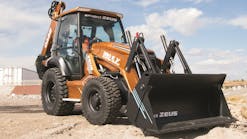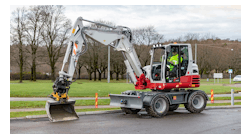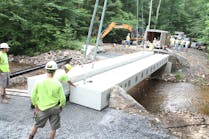Compaction Equipment
There are four broad categories of soil compaction equipment: handheld rammers and tamping plates, vibratory and static sheepsfoot, vibratory and static rollers, and pneumatic tire compactors.
Rammers and Tamping Plates
Often referred to as “jumping jacks,” handheld vibratory plate compactors and rammers are used for those situations that do not require production of large quantities of compacted soil for soil compaction efforts confined to small areas. Like their cousin the jackhammer, tampers and rammers use centrifugal force generated by machine vibration induced into a flat contact plate to compact soils. They come in two types, one way or reversible. With a one-way tamping plate, the operator can only move forward with his machine as it performs compaction. A reversible tamper allows the operator to move back and forth over the area he is compacting.
Small compacted soil quantities are usually required for small repair and maintenance work done to failed areas (or areas that were not compacted correctly in the first place) of a liner or embankment, the compaction of soil in confined areas (such as along the bottom of a trench), or small quantities of granular soils (such as sand, gravel, crushed aggregate, or mixed soils used as the base for small paved areas). When working in confined spaces, such as a trench bottom, where the operator cannot easily make a full turn back to his stopping point, reversible tampers and rammers are a necessity. Diesel rammers provide the power necessary for heavy-duty compaction in areas to small for heavy soil compaction equipment. Neither a vibratory plate nor a power rammer is suitable for use in wet clayey or otherwise cohesive soils, though vibratory tampers work well on soil with low to moderate fines content.
Multiquip Inc. manufactures a complete line of rammers and vibratory plate tampers. Its rammers can run either on diesel or a four-cycle gasoline engine. With contact shoes ranging from 5.9 inches to 1.2 inches, Multiquip’s MT series delivers ramming forces from 1,215 to 3,500 pounds at up to 700 blows per minute. In size they start at the lightweight and easily portable MTR40F to the MT84FA with its 3.5-horsepower engine. Even heavier are Multiquip’s rugged diesel models, the MT76D2 and the MT86D2, which can pound a 13-inch shoe with a force of 4,400 pounds. The company also offers a line of forward and reversible plate compactors powered by 2.4-horsepower to 6.0-horsepower engines designed for the efficient compaction of sand, gravel, and cohesive soils. The reversible plate compactors also come equipped with two eccentric weights, which increase the compaction force while allowing for a smooth transition from forward to reverse.
In addition to its lines of planers, pavers, and vibratory rollers, Dynapac produces vibratory plates and rammers. The company’s LF series of single direction plate compactors delivers (at the light end) 2,000 pounds of force at a frequency of 5,520 revolutions per minute (rpm) to 4,725 pounds at 5,100 rpm. Vibratory jumping jack plate tampers, the LT series, are suitable for small repair jobs and confined spaces. Rounding out Dynapac’s product line are its LG series of gas-powered reversible plate compactors designed for compacting either asphalt or granular soils. For bigger jobs, there is the LP series of diesel-powered, walk-behind vibratory drum rollers.
Amman America produces four-stroke diesel rammers and two-stroke gasoline rammers for small compaction jobs. A wide variety (80 different types) of vibrating compactors is also available from Amman, allowing for site-specific compaction applications. In addition to traditional forward and reversible plate compactors, Amman offers remote-controlled models. Complementing this product line is a specialized line of rollers for trench compaction, both the light AC series for trench compaction and the tandem roller AV series for base compaction.
Sheepsfoot and Padded Rollers
Sheepsfoot rollers, so the story goes, were born out of the observation that the soils adjacent to the gate of a sheep hold were dense and stiffly compacted as the result of thousands of little sheep hooves pounding the earth. With this observation came the realization that force concentrated into many small “footprints” could be more effective on some soils than the same weight applied to a broad flat area impacted by a smooth drum roller. Sheepsfoot rollers are also known as tamping rollers. They resemble a smooth drum roller with projecting club-shaped feet fixed to the drum’s surface in a regular pattern. The roller drums themselves are empty, and the additional weight is provided by water or sand fill. The operating mass of a sheepsfoot roller can vary between 5 and 8 tons. Though mostly used on cohesive soils, they can be used on sands and gravels with sufficient fines and moisture content. Sheepsfoot rollers are not used on very coarse soils and uniform gravels.
Certain distinctions should be made between sheepsfoot rollers and the similar padded foot rollers. The sheepsfoot contact points are peg shaped and more deeply penetrating than those of padded foot rollers. As such, sheepsfoot rollers are mostly used to tie together via compaction and secondary kneading separate layers of clay. Usually, the clay is placed in loose lifts as thick as the length of the sheepsfoot itself; an 8-inch loose lift is fairly common. Repeated passes by the sheepsfoot roller compacts the loose lift and binds it to the lower, previously compacted lift, resulting in a newly compacted layer of about 6 inches in thickness. Such an operation is typically performed to construct compacted clay liners for landfills and other impoundments. Sheepsfoot rollers come in both static and vibratory types (adding dynamic compaction along with the static pressure and kneading). They also come in pull-behind models (typically hitched to a large dozer) or self-propelled ride-on models with one or two rollers.
By contrast, padded foot compactors are of a shallower rectangular shape but can also be used to compact clays. However, a padded foot’s penetration is less than that of a sheepsfoot but is also used in earth compaction primarily for sub-base construction. When used for sub-base construction, padded foot rollers more resemble smooth drum rollers in application. While the sheepsfoot roller is ideal for achieving low permeability, padded foott rollers are suitable for achieving strength compaction. Both are different than the smooth drum compactor, which is used on dry materials such as granular soils used to construct road base.
Caterpillar’s newest addition to its extensive line of soil compaction equipment is the 825H soil compactor. With an operating weight of 72,164 pounds and powered by a 453-net-horsepower C15 ACERT engine, the 825H is designed to meet aggressive Tier 3 emission standards. While adding a new engine and cooling system, it retains those features that made the old 825G a success (high-efficiency hydraulics, ease of use, durable frame structure, etc.). Its engine is designed to reduce emissions while ensuring constant power by means of an electronically configured transmission system that provides constant horsepower throughout its operating range. This addition to its line of compaction equipment complements Caterpillar’s established padded foot and smooth drum CP series and CS series vibratory soil rollers. The CP series machines range in size from 10,190 pounds to 37,050 pounds and are designed to operate on uneven or steep terrain. The CS series machines are designed for site preparation and base compaction applications. Some of these models come with optional padded foot shell kit for differing applications.
Bomag provides static, padded foot compactors in the heavy weight class, the 35-ton BC772 and the 29-ton BC672. Able to handle large earth compaction jobs such as dam embankments, they are high-speed compactors driven by water-cooled diesel engines protected by complete underbody enclosure. The enclosed frames fully protect the hydrostatic drives, axles, and engine compartment, protecting them all from dirt penetration. One interesting feature is the special polygonal wheels with high-torsion-resistant padfeet shaped to maximize static compaction.








